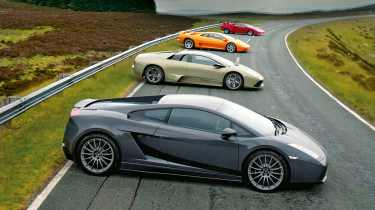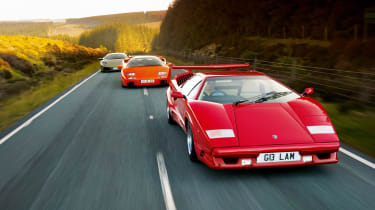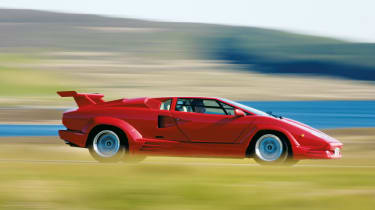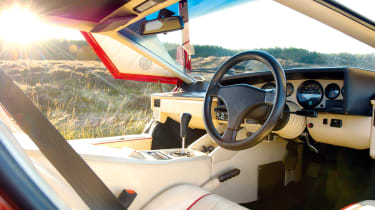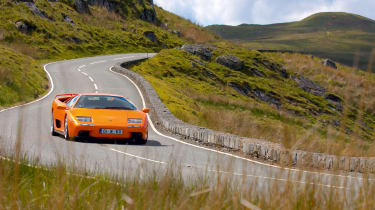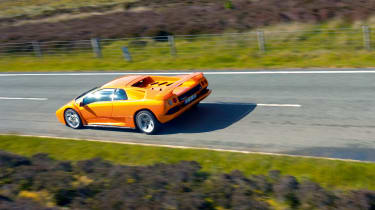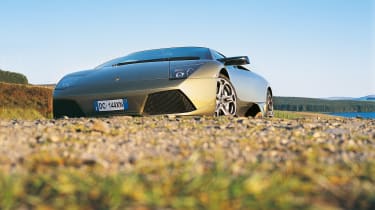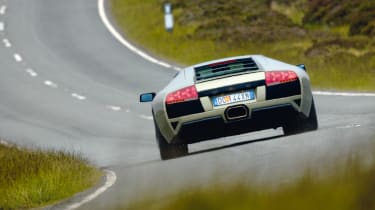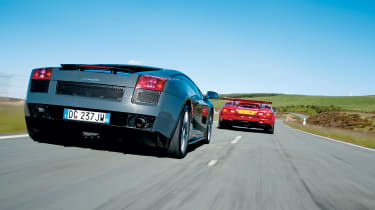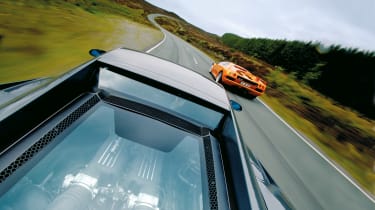Lamborghini Gallardo Superleggera vs V12 flagships
Was Lamborghini’s V10 line ever the threat to the V12 big-hitters that it was once perceived to be? We find out as Gallardo Superleggera, Murciélago LP640, Diablo VT 6.0 and Countach Anniversary lock horns
Reach up, grab the thick wedge of door trim and pull down firmly. Sssscchhhh-click. Then silence. Just the sound of your heart thumping slightly faster than usual, the smell of soft Italian leather and the sight of the world rendered into a lustrous panorama by the massive expanse of glass.
The shrill drilling of a fast-spinning starter motor cuts the silence for maybe a second, then cylinder by cylinder the big V12 wakes up with a nape-prickling, urgent bark. It’s a dense, busy noise. If somebody played you a recording of it you’d know from its sheer complexity that it was a V12, but with a blip of throttle all the constituent parts meld into a tight, smooth howl. Chaos is ordered into sharp focus. This is the essence of Lamborghini. It always has been.
> Final Lamborghini Aventador coupe to be auctioned alongside virtual NFT replica
Well, at least it was until the short, squat Gallardo arrived in 2003. With a clean-sheet V10 instead of a development of the classic Giotto Bizzarrini-designed V12, an interior that poured solid Teutonic ergonomics into a laid-back Italian aesthetic, and (the horror!) conventionally opening doors, it forced us to reassess what a Lamborghini could be.
More reviews
Group tests
- Alpine A290 v Alpine A110 – how much DNA do they really share?
- Ariel Atom 4R v Caterham Seven ‘evo25’: power-to-weight heroes go head-to-head
- Caterham Super Seven 600 v Super Seven 2000
- Levante v T1
- Corvette Stingray v Porsche Cayman GTS v Audi R8 RWD
- Great Ferrari hypercars driven: 288 GTO, F40, F50 and Enzo head-to-head
- Hardcore Ferrari V8 specials go head-to-head
- Lamborghini Aventador Ultimae v Lamborghini Countach
- Lotus Emira v Morgan Plus Four – four-cylinder Brits go head-to-head
- Toyota GR86 v BBR Mazda MX-5: supercharged drop-top battles sports coupe
In-depth reviews
- Abarth 600e 2025 review – Italy gives the Alpine A290 something to worry about
- Alpine A110 review – distinctive, lightweight and unforgettable to drive
- Audi R8 (2015 - 2024) review – the ultimate soft-focus supercar
- Bentley Continental R Mulliner: review, history and specs
- BMW 5-series review – is this still Munich’s anchor model?
- BMW 1-series review – Munich’s Audi A3 rival gains focus
Long term tests
- Abarth 695C Turismo Fast Fleet test – 10,000 miles in the Italian hot hatch
- Alfa Romeo Giulia Veloce Fast Fleet test – 7000 miles in the sharp Italian saloon
- Alpina B10: end of term report
- Alpina B10
- Ford Mustang GT
- Ford Mustang GT
- Ford Mustang GT
- Land Rover Defender 110 Fast Fleet test – 9000 miles in the go-anywhere SUV
- Maserati Ghibli Trofeo Fast Fleet test – 4000 miles in the Ferrari-powered saloon
- Mitsubishi Evo MR 340
Review
- New Aston Martin DBS 770 Ultimate review – 759bhp super-GT driven
- New Bentley Batur 2023 review – can it possibly be worth £1.65m?
- 2023 Chevrolet Corvette C8 Z06 review – the American 911 GT3?
- Kia EV6 GT-Line S prototype review – the EV that shows how it’s done
- BBR Supercharged Mazda MX-5 (ND) 2023 review – tuned 250bhp roadster driven
- MG4 Trophy 2023 review
Reviews
- Abarth 695 75 Anniversario edition 2024 review – a fitting send-off for Abarth’s hot supermini?
- Abarth 500e 2023 review
- AC Cobra 378 Superblower MkIV 2021 review – another V8 Cobra, but with a GM heart this time
- Acura Integra Type S 2024 review – a Honda Civic Type R with added restraint
- Alfa Romeo Giulia 2025 review – get one while you still can
- Alfa Romeo SZ: history, review and specs of an icon
- Alfa Romeo 1750 TBi
- Alpina B3 GT Touring 2025 review – a 190mph alternative to the BMW M3 Touring
Of course, there had been ‘small’ Lamborghinis before – the Urraco, the Silhouette, the Jalpa – but, with the Gallardo, the junior Lambo grew up to such an extent that people wondered aloud if the Murciélago was effectively dead. The traditionalists mourned (a little prematurely as it turned out), but there was little doubt that the new V10 supercar had hit its target: Ferrari felt hot breath on its collar for the first time in decades and new customers flocked to a brand that had hitherto been out of reach.
Maybe the harder, faster, louder and downright rude Gallardo Superleggera was more suited to those traditionalists. When it arrived in its first incarnation in 2007 there was a sense that it was the Gallardo that everyone at the factory had always wanted to build. It’s a Gallardo shorn of weight, every sinew rippling with purpose and intent. It’s a Gallardo concealing even more power and equipped like never before to unleash every scrap of it to the road. There’s no doubt that it’s a true Lamborghini. Perhaps, at the time of its arrival, the greatest ever.
Now, that sounds like a challenge…
Miura, LP400, QV, SV, GT… we could have chosen any number of cars that equally capture the spirit, glamour and aggression that have formed the legend of Lamborghini. So why the four you see here? Well, anything with fewer than ten cylinders was out, so too anything with an engine mounted up front (even though it would have been a laugh to have brought an LM002 along). The Miura, still the most beautiful Lamborghini of all time and perhaps the most significant, was harder to dismiss. However, although they are an intoxicating drive, the cruel truth is that, in terms of sheer pace, Lamborghini’s original mid-engined V12 would be easy meat for a well-driven hot hatch today.
Choosing the ultimate Countach was just as contentious, but we felt that in order for it to stand toe to toe with the newer cars we needed the fastest, the most aggressive and the most outrageous. It had to be an Anniversary.
The Diablo dynasty is glorious, and our shortlist came down to the lightweight SV, the sensational carbonfibre GT and the immensely talented swansong, the simple VT 6.0. We would have loved to have brought together all three, but in the end it fell to the version we felt had fully realised the Diablo’s previously latent potential. The 6.0 was in.
The final contender was easy. It had to be the Superleggera’s V12 contemporary, the Murciélago LP640 – all 631bhp of it. The natural successor to the crazy Countach and Diablo, the traditional Lamborghini reinvented in the era of Enzos, Carrera GTs and Zondas.
The venue for this feast of horsepower was much easier to choose. Nowhere reveals every facet of a car’s character and abilities quite like the roads that sweep and loop across north Wales. It’s an epic stage, so massive that you can’t escape a heavy cloak of humility when you survey the surroundings. And today God’s special effects department is doing its bit to help – Wales is drenched in brilliant dazzling sunshine and a Mediterranean sky of the deepest azure drapes lazily over the spectacular scenery. Over 1000 miles from Sant’Agata, these Lamborghinis couldn’t look more at home.
Lamborghini Countach 25th Anniversary
‘Countach!’ legend has it, was Nuccio Bertone’s exclamation when he first saw Marcello Gandini’s new Lamborghini prototype. There’s no direct translation for this wonderful piece of Piedmontese dialect, but ‘Wow!’ sort of sums it up. The 1970s must have been a gentler, more well-mannered time, because when Jim Wiltshire’s Candy Red 25th Anniversary Countach arrives in our midst the air turns blue. I guess it’s a good job John Barker, John Hayman, Henry Catchpole and I don’t get to name new supercars…
Gandini’s intricate wedge of metal origami shocked the world at the 1971 Geneva Auto Salon. Finished in bright yellow, the Lamborghini Countach LP500 literally stopped the show. A Miura SV sat beside it, but nobody really noticed.
‘LP’ stood for ‘Longitudinale Posteriore’ (the position and layout of the engine, which was no longer mounted transversely, as in the Miura), while the 500 was reference to the prototype’s 5-litre version of the classic V12. Lamborghini claimed the new engine would produce 440bhp and propel the LP500 to 200mph…
Unfortunately the bigger engine proved fragile in testing and the LP’s development was tortuous. When the production-ready Countach was finally launched in 1974, its V12’s 3929cc capacity was rather less impressive. Even so it was said to produce 375bhp at 8000rpm and be capable of taking the LP400 (as it was now called) on to 180mph. Only the Ferrari Daytona could get close.
The Countach remained Lamborghini’s big-hitter until 1990. By then it was a very different supercar, the lean precision of the LP400 obscured by outrageous addenda of dubious taste but unmistakable drama. The evolution began in 1978 with the LP400S, which took advantage of Pirelli’s new P7 low-profile tyre. Then, in 1982, came the LP500S, which brought a capacity increase to 4.8 litres, although power remained pegged at 375bhp. Next was the LP500 QV in 1985, the increase to 5167cc and introduction of four valves per cylinder (hence ‘QV’, for ‘quattrovalvole’) taking the horsepower count to a fulsome 455bhp.
To mark Lamborghini’s quarter century as a car manufacturer, the Anniversary was released in September 1988. Styled by Horacio Pagani (yes, that one) and with extensive chassis development by former Italian and European rally champion Sandro Munari, the steroid-infused 5.2-litre 455bhp Anniversary may not be to everyone’s taste, but it is widely regarded as the best Countach to actually drive. Which is exactly what I should be doing…
Let’s not get ahead of ourselves, though. You don’t just jump in and drive the door handles off a Lamborghini. You want to savour those moments before you pull the scissor door up into its arc and fall into the thinly padded seat. With the Countach those moments tend to drag into minutes. In fact you could just look at it all day long. The Anniversary may not be conventionally pretty, but it is as big a statement as has ever been made with aluminium and four wheels. Every duct is hugely exaggerated, every sharp crease bursting with tension, and that (optional) rear wing is the final poke in the eye to sensibility. On one hand the Anniversary is a fascinating period piece, the epitome of ’80s excess, but that sells it short because even today Gandini’s middle-aged wedge still shocks. Nothing draws reactions as honest and unfiltered as the Countach.
Drop backside-first into the pinched seat and pull your legs in behind you over the high sill. This car has the sport seat option, which is a relief as the plusher, electrically powered standard items make the Countach a nightmare for anyone over about 5ft 10in. So I can sit up straight, but the pronounced side bolsters make the seat so narrow that my frame only just squashes itself down onto the seat cushion. Broader drivers might find themselves clasped into place but suspended a few centimetres above the seat base.
To your left, mounted on the narrow transmission tunnel, is an open-gated gearshifter – dog-leg first, metal surround finished in matt black. Ahead there’s a plain three-spoke steering wheel, beyond that a rectangular instrument binnacle that looks like it could have been made out of an old shoebox. Despite the wheel’s tiny diameter you get a good view of the speedo and the rev counter. Note the markings – up to 320kph (199mph) on the former, the first red marking at 7500rpm on the latter.
Push the flimsy key into the ignition barrel on the left-hand side of the steering column, gently squeeze the accelerator three times to engorge the six carbs and then twist towards you. The dentist’s drill of a starter motor spins and then the V12 catches cleanly. You won’t be able to resist a quick blip and you won’t regret the indulgence: the 12 cylinders spin up in a flash and the quad exhausts emit a pure, trebly howl.
The gearbox action is heavy, almost like it’s lacking oil, and the clutch is pretty beefy too. Worse, the throttle feels solid for the first millimetre or so of its travel and then frees-up instantly, making pulling away a fraught juggling act between bogging down and potentially stalling or sounding like you’re trying to extract a 0-60 time (apparently this is a trait of all right-hand-drive examples). So far the legend of the truculent Countach is spot-on.
Then there’s the steering. It’s massively heavy at manoeuvring pace and remains unusually weighty even as you slot deliberately into second and then third. However, it’s immediately apparent there’s a rich stream of information flowing back through the tiny wheel, and the Countach rides with a finesse that’s at odds with its low-speed awkwardness. Meanwhile the engine’s willingness to rev and the response it elicits in terms of acceleration shed any remaining doubts that the Countach will be a ham‑fisted irrelevance.
In fact, with the V12 ripping up to 7000rpm (we stopped revving at the yellow line) and the fat 225/50 ZR15 P Zeros guiding the shovel nose into each apex, the Countach feels genuinely quick. The searing, wailing cacophony, a mixture of hungry induction and exhaust yowl, adds to the sense of speed, and you’re so focused on getting gearshift and throttle inputs to fuse smoothly that the fearsome soundtrack edges you towards sensory overload. It takes a good few miles to actually think clearly and feel what the Countach is all about, to break down the experience and analyse its behaviour. Initially it’s just noise and heat and power.
Take a few deep breaths, relax a little, and you start to appreciate that under the shock-and-awe tactics there’s a talented chassis. Body roll is contained well and the engine never feels like a threatening mass ready to come around on you if you so much as dare to brake into a turn. You sense its mid-engined configuration from the gently writhing front end and the stupendous traction rather than from an uncomfortable roll-oversteer balance. The Countach corners flat and very securely and the simply enormous 345/35 ZR15 rear rubber feels absolutely keyed in on dry roads.
There are limiting factors, of course. Chief amongst these is the brakes – acceptable in the late ’80s but pretty hopeless in modern terms. The steering, too, hinders your commitment. It’s so heavy when loaded in a turn that the thought of having to find a quick and accurate correction knocks mph from your entry speed. This is a car you relax into and enjoy within its limits. And then there’s the engine, very much the star attraction, but producing 455bhp? Well, at least 100 of those seem to be spent making noise rather than turning the rear wheels…
Click-sssscchhhh… I emerge from the Countach with a huge grin. Barker has already sampled this immaculate Anniversary and he seems to have enjoyed it as much as I just have. ‘The V12 doesn’t feel like it’s giving over 450bhp,’ he agrees, ‘but it certainly sounds like it. The mid-range is a multi-voiced cacophony and from there it just gets stronger – it spins so sweetly to 7000rpm. It prefers smooth, quick roads but I can’t imagine really attacking at ten-tenths in it. I suppose you don’t need to in order to become totally absorbed in the experience, anyway…’
Lamborghini Diablo VT 6.0
Long-time Lamborghini zealot Hayman, meanwhile, has been reacquainting himself with an old friend, the Diablo VT 6.0. Owner Jenny Rothwell bought this gorgeous Pearl Orange example shortly before our test, and out of respect for her and the car Mr Hayman has been driving it flat out for the last 15 miles or so. Quite right. His thoughts? ‘I always look back fondly on these – it was my favourite at eCoty 2000 – and I thought maybe it’d be a case of rose-tinted spectacles. But not a bit of it. The 6.0 still has the magic.’
Sounds like I should try it for myself. Still slightly flushed from my Countach experience, the very generous Ms Rothwell virtually drags me over to the Diablo and thrusts the key into my hand. ‘See what you think,’ she says.
‘Erm, well, if you insist…’
Wow. That’s all I can think when I’m locked into position, steering wheel pulled close, dazzling orange bodywork filling the widescreen mirrors, cool alloy gearstick resting in my left hand. One of the all-time great evo photographs must be the one of a similarly hued Diablo 6.0 back in issue 022. A low-down rear chasing shot, empty road stretching into the distance, rich blue cloudless Italian sky picking out every delicious curve on the car’s body. Gus Gregory captured that perfect moment back in 2000, and now I feel like I’ve dived into that shot and muscled the driver out of the way to take that frame and stretch it out into an unforgettable sequence.
Everything feels more exaggerated in here than in the smaller Countach. The speedo now reads in mph, all the way to 220; the yellow zone on the rev counter now begins at 7200rpm. The steering wheel – with carbonfibre trim – is still quite small, but you can get it much closer to you, allowing a Grönholm-style driving position. And all around there’s masses of bodywork. You feel even closer to the pointy end, like your legs reach beyond the front axle, and that mighty 6-litre V12 feels a long way behind. Glance in the rear-view mirror and you see buttresses that funnel back for what seems like miles, finally stopping in the shadow of the vast spoiler. This is a big, intimidating car.
A dozen years on from the Anniversary, this Diablo was the first Lambo developed under the watchful eye of Audi. And it shows. Quality is unrecognisable from that of the wonderfully hotchpotch Countach, switchgear now borrowed from Ingolstadt instead of Turin, and everything feels more substantial and more thoughtfully designed. Have no fear, though. At its heart the final Diablo is still rooted in Sant’Agata. The 6-litre V12 produces 543bhp at 7100rpm and 457lb ft at 5500rpm, enough to punch its clean profile through the air at over 200mph (without the wing) and to launch it to 62mph from rest in under four seconds.
Despite the added weight burden of its four-wheel-drive system (the VT in its name stands for ‘viscous traction’), the use of carbon for everything bar the aluminium roof and doors means that, at 1625kg dry, the 6.0 is just 57kg heavier than the shorter, narrower and lower Anniversary. You’d swear it was lighter still. The steering is perfectly weighted and quick enough to make the big Diablo feel genuinely nimble. It’s alive with feedback too, proving that power-assistance doesn’t have to rob you of feel. Meanwhile, the gearbox (still a five-speed with a dog-leg), clutch and throttle are all much more manageable. Maybe not Golf light, but certainly requiring no more effort than, say, a TVR. The 6.0 is light on its toes, too. Softer in its vertical absorption than the Countach, making for a very supple, fluid gait, but also more controlled when you start to string a few corners together. Where the Anniversary’s damping might run out of ideas, sending the wheels skipping across the surface, the 6.0 simply glides serenely.
The gearbox is a peach, requiring precision timing and some physical effort, but rewarding with a fast, mechanical action and a delicious clack! as it slots home. Not that you seem to change very often – the Diablo has an epic stride, with second gear stretching beyond 90mph and third pushing deep into three figures. To be honest, this does dull the expected viciousness of its near 550bhp, but the payback is enjoying the huge engine’s mighty and ever-changing delivery without any punctuation, and this approach suits the polished, poised, unhurried chassis.
Like the Countach there’s a bit of understeer to nudge up against, but it’s harder to find on the road as grip levels are much higher. The four-wheel drive allows you to jump on the power as soon as the nose has dug in without any fear of power oversteer. You certainly feel liberated to work its massive tyres harder than you might the Countach’s. However, unlike the older car, the Diablo, perhaps because of its supple suspension, feels more conspicuously mid-engined when you really start to push hard. Hit a big bump mid-corner and the front doesn’t budge, but the rear becomes unsettled, floating momentarily and threatening to slip wide. It rarely does, but the harder you push, the more you have to be aware of that massive V12 pendulum.
Which isn’t to suggest the Diablo is untrustworthy. In fact, through smooth corners it feels totally hooked up. It’s just that when you’re asking the car to slow down, change direction and contain its rear-biased mass on a cresting corner, or one that drops away sharply, physics start to take over. Most of the time the VT feels like a friendly old beast, though, and it’s a fantastic sensation as it squats down under acceleration out of a corner and the steering lightens in your hands. Even Catchpole, who was full of trepidation before stepping into the 6.0, is won over. ‘It’s like a big scary bouncer that lives with his nan,’ he says. ‘Remarkably friendly.’
Disappointingly the brakes don’t feel like they’ve benefited from 12 years’ worth of development. On a flat bit of road, and if you haven’t been working them consistently hard, they work pretty well. Throw in a few bumps, though, and the ABS triggers even with fairly light pressure on the middle pedal – odd considering there’s plenty of front grip. If you’ve been exercising that V12 for the last few miles the pedal feel goes west, too, and a soft, long pedal that pulses furiously on the way into a bend is not something you expect when the rest of the package feels so well sorted. It is perhaps the Diablo’s only real weak link.
Such has been the speed of development of supercars since the millennium that both Countach and Diablo are almost pensionable, but the old-timers have put on a phenomenal show. OK, so the Anniversary doesn’t feel like it could ever reach 183mph, not unless it was pushed out the back of a Hercules at 35,000 feet, and even the Diablo doesn’t feel as manic or aggressive as you might expect, but both still tick all the supercar boxes. They ooze charisma, fill driver and bystanders alike with that childlike glee that only an impractical mid-engined car with scissor doors can, and, at sane speeds, deal with these roads with a casual shrug. The progeny of the Countach and Diablo have a lot to live up to.
Lamborghini Murciélago LP640
It seems fitting to scribe a neat line from Countach to Murciélago, so with the 6.0 still tinkling and clicking as it sheds some of the enormous heat that a 543bhp V12 generates, I grab the chunky key to the LP640. I’ve spent a lot of time with various Murciélagos, but familiarity doesn’t dim the big Lamborghini’s incredible presence. It’s a beautiful shape. So beautiful that even in military green you ache to own it.
Barker has already driven the LP640 and the Superleggera. He doesn’t want to give too much away but muses on the low-key colour schemes of both the Murciélago and the undercoat-spec Gallardo: ‘The subtle, weapons-like hues of the pair reflect the shift in attitude at Lamborghini. Even more so than their predecessors, these are serious driver’s tools.’ Hmm… intriguing.
Same ritual to get in, same sense that you’re in a big, old-school supercar. Starter motor drills that same high-pitched tune, too. But milliseconds after you turn the key, the LP640 experience deviates from that of its ancestors. The engine doesn’t catch cylinder by cylinder, noise building layer upon layer, it explodes with an intense whoop of revs, then settles to a rock-steady, digitally programmed idle. Blip the throttle and the needle flicks around the rev counter with seemingly no inertia. It’s not quite Carrera GT-responsive (little bar an F1 car is), but, incredibly, the 6.5-litre development of the Bizzarrini V12 feels cutting edge.
No gated ’shifter here, no need to juggle a heavy clutch with a sticky throttle. Just flick the right-hand sculpted alloy paddle to select first, ease off the brake pedal (noting how its action is short and very, very firm) and the 631bhp V12 sets the sticky Pirelli P Zero Corsa tyres rolling. The gorgeous suede-rimmed steering wheel immediately gives the LP640 an edge; subconsciously you know it’s there to soak up moisture from your palms. The steering itself is heavier than that of the Diablo, but this only adds to the sense that this Murciélago is a tougher, more serious piece of kit.
The LP640 had a tight brief. It’s almost as though Lamborghini knew that all the peripheral supercar stuff – the drama, the charisma – was taken care of simply by that shape and that engine, so instead it focused on the thing that matters when the scissor door has been pulled shut: the way it drives. The LP640 is all about clenched-fist dynamics, about getting from one place to another in the minimum time frame. It’s angry – with you, with the road, with anything that might slow it down – and you’d better be up to it. A supercar tamed by Audi’s cool influence? Right now it feels about ten times as scary as the Countach or Diablo…
We’re running in convoy, the LP640 in Sport mode, quickening the gearshifts, adding a superfluous extra burst of revs on downshifts and allowing the V12 to spin up to 8000rpm (without Sport engaged it hits a very abrupt limiter at 7500rpm). The structure feels rock solid, the damping is tight – the ride is much firmer than the Diablo’s – and everything you touch exacts a measured, consistent reaction. It’s so stable, so composed through direction changes that you can feel that the engine is mounted lower than in the Diablo. The gearshift is quick and smooth, better than earlier e-gear examples; the carbon-ceramic brakes feel simply mighty.
That sixth ratio allows the LP640’s lower gears to be stacked tighter, but the 6.5-litre engine hardly needs that advantage. Quite simply it blows the Diablo 6.0 into the weeds. The acceleration is effortless at low revs, then at around 4500rpm the thumping torque starts to give way to manic horsepower. Such is the noise and the ferocity of the delivery that by 6000rpm you’re instinctively pawing for the upshift paddle, but you must fight the urge, because it’s beyond that where the LP640 truly rams home its advantage. It kicks hard, the noise focusing down into a single piercing howl as 8000rpm approaches.
It’s no surprise that the LP640 charges harder than its predecessors, but by how much you wouldn’t quite believe. And it’s the way it controls its mass, the way the body never gets out of phase with the wheels and the road, that is truly spectacular. I’ve driven this same road in Ferrari’s 360 Challenge Stradale, a Noble M400 and various 911s of a similar vintage, but none is so immune to its wicked compressions as the LP640. There’s one braking zone you arrive at after a stomach-churning crest, the car light and unsettled. As you hit the middle pedal the road is still falling away from you, but as the brakes start to bite it begins to climb rapidly. The suspension has to deal with the weight of the car settling back down after the crest and heavy braking and the gradient of the road simultaneously. The Stradale bottomed out so alarmingly here we actually stopped to make such its venturis hadn’t been sheared off, the 996 GT3 RS thumped its bump-stops and skittered unnervingly; even an Enzo couldn’t keep its belly off the road. But the LP640 simply checks its body movement, zips through the compression and then attacks the following right-hander quicker than any of the aforementioned. Total composure.
By now the Countach and Diablo are nowhere to be seen. In fact when I pull over I can hear them coming for a good minute before they actually appear on the horizon, first the 6.0, then the Anniversary. Hayman clambers out of the Countach and it seems he’s unconcerned that he’s just been dropped like a diesel Corsa: ‘Proper drop-dead looks, proper soundtrack, proper old-school supercar – not perfect, for sure, but it’s really tugging my heartstrings. You have to make some allowances for its age, the brakes particularly, but in terms of steering feel it’s right up there with the Diablo for me, and you can still hustle it along at a fair old lick.’
He’s right, of course. It’s just that ‘a fair old lick’ and what the LP640 can achieve are two very different things. Speed isn’t everything, though, and Barker is falling back in love with the Diablo: ‘The 6.0 is a car that really flows and feels connected. Yes, you know you’re in charge of a big mid-engined car, but the poise that the damping delivers and the precision of the steering give huge confidence. In some ways it makes the LP640 seem a bit edgy. Oh, and it’s a manual – a weighty, deliberate shift – but that doesn’t date the car, it just gives you another ingredient to reap reward from. I love it.’
Me too, but I’m struggling to see past the LP640’s pace, control and sheer energy, which it serves up with a lush cinematic flavour that’s pure Lamborghini.
The sunshine is ebbing away and the clear sky drawing in with heavy clouds when I finally get to sample the Superleggera. It’s a bulldog of a car, broad and muscular and bunched-up, a ball of aggression. The grey finish camouflages the carbon details (sill extensions, engine bay surround), but, as Barker suggested, it’s a clear statement of intent. This is not some frivolous trinket, it’s a weapon.
Lamborghini Gallardo Superleggera
Swing open the door – no effort required (the lacquered carbon trim sees to that), no look-at-me special effects – and fall into the seat, carbon again, and much more upright than those fitted to the V12s. Its Countach-tight and fitted with a four-point harness. Glossy carbon adorns the centre console and even the lower quadrant of the flat-bottomed steering wheel. Everywhere else there’s black Alcantara. It seems only right and proper that instead of a conventional stick there are two paddles peeping out from behind the wheel. For sense of occasion it’s got the Lamborghini act down to perfection.
The Gallardo feels tiny after the LP640, all wheelbase and ruthlessly cut-off extremities. Concentrated supercar. Supercar deconstructed and then reformed with no waste, nothing surplus to requirements, just a bucketload of serious hardware and a supersized side order of attitude. The V10’s flat blare fits the sinister stance perfectly, and the deep, ugly noise that builds with every rev only heightens the sense that you’re piloting a different sort of Lamborghini.
The ride is hard. Every bump is felt through the carbon seat, and yet the Superleggera doesn’t tramline or hop and skip when the surface deteriorates. The wheels are always firmly in touch with the ground, and although there’s not a lot of steering feel you know there’s plenty of grip to lean on from the way the front tyres lock instantly onto line. Nail the throttle and it responds with the same snap. There’s so much torque you’d be forgiven for thinking it was turbocharged.
A full day on these roads means I’m fully dialled in and quickly up to speed. Immediately it’s obvious that the Superleggera is right up there with the LP640 in terms of sheer pace. Shorter geared and with rippling torque and less weight to carry, the 5-litre V10 gets working from tickover and never really lets up. The initial punch is too much for the LP to live with, but it doesn’t quite have the crazy top-end kick of the Murciélago. Even so you’d swear it had more than a 9bhp advantage over a ‘standard’ Gallardo.
But that’s only half the story, because it’s the Superleggera’s chassis that really stuns. I’ve mentioned the control – of the wheels and the body – which is boundless and easily appreciated even at seven-tenths. Push harder, though, and you slowly uncover the Gallardo’s almost supernatural levels of grip. It’s on P Zero Corsas, like the LP640, so you expect a faithful front end, but this is something else. You turn, it responds, so you try harder. No change, just grip and instant response. Harder still, not even a whiff of understeer.
OK, time for a big commitment. The front tyres turn and bite simultaneously, there’s no body roll to speak of and certainly no slip at the front. The rear tyres follow, but now you sense them just edging a few degrees wide. Not really sliding, just taking up a bit of attitude to glue those sticky front tyres to the apex. Incredible.
Try again, this time through a fast left-right combination, and it’s better still. It manages to tear chunks out of the road and yet still feel on tiptoes, flicking from one direction to the next with total security yet a fluid, effortless poise.
Such is the Superleggera’s composure and raw speed that it throws any tiny weakness into sharp focus, and there are two glaring holes in its armour. The first is the e-gear ’box. It should be as smooth as the LP640’s, but it isn’t. It thumps changes through with no finesse and there’s no pay-off in terms of shift speed. The Gallardo’s downshifts, too, are pretty clumsy, and made all the more disconcerting by the other problem area: the brakes. Oh, they stop the car all right, as you’d expect with 365mm carbon-ceramic discs and eight-pot calipers up front, but you don’t have enough say in exactly when and where. Pedal feel is awful. On light applications it’s mushy and inaccurate, making the Superleggera very tricky to drive smoothly. Up the pace and it’s worse. You go for the brakes and get nothing but dead travel, then in a mild panic you push the pedal a bit harder. Suddenly the brakes bite – really bite – and you shed too much speed and wreck your approach to the corner. On the road, where you often need subtlety rather than brick-wall power, it’s almost impossible to drive around the problem. Maybe they work better on track, but out here they really slow you down. On reflection, maybe that’s a good thing…
Later I follow Barker – him in the Superleggera, me in the LP. He’s just climbed out of the Countach so I know I’ve got a good couple of miles before he gets his head back into maximum-attack mode. The LP easily keeps him in reach as the road winds up a hillside and then plateaus across a vast plain raggedly slashed by this perfect bit of tarmac. The Gallardo’s exhausts spit an angry stab of V10 on downshifts, a warning shot to the LP maybe. The pace escalates, but the Murciélago responds, losing a little ground into corners but shrinking the gap in mighty lunges of acceleration on anything vaguely resembling a straight.
Now the road is kicking and turning like a rollercoaster and the Gallardo is in full flight. I’m using every last one of the LP’s 631 horses and calling on all the braking power it can summon. The traction control is off (it’s a hyper-sensitive system that is best disabled in dry weather), but the Murciélago stays composed, remarkably so – just a bit of understeer here, a little twist of correction needed there. What a feeling! And what a sight. The Superleggera looks like a slot car, such is the speed with which it changes direction, and as the tyres hook into the surface a shower of shale is thrown up behind it. Finally, through a series of demanding left-right flicks, the Superleggera steals a meaningful lead that the LP640 can’t recover. The baby supercar is all grown up, and there’s the proof.
I’m stunned. Both by the LP640’s incredible engine and awesome control, and by the Superleggera’s mind-boggling point-to-point speed. The Countach and Diablo, in every rational sense, are out of their depth. And yet when I ask anyone to rank the four cars, they look at their shoes and mumble something about them all being wonderful.
I’m not surprised. Throw a Lamborghini into any group test and choosing a winner becomes an emotive, soul-searching dilemma. With four of them it’s like some sort of group therapy session. Sorting out a clear finishing order is almost impossible. Barker, Hayman, Catchpole and I all have different lists – in fact Barker has two: ‘I want a Lamborghini’ and ‘I want a Lamborghini to drive fast’ – but one car emerges as everyone’s number one.
‘The engine is the core reason that I feel so passionately about it. Not just the thrust, but the noise and the feel of it climbing its power curve. And the chassis – so forgiving but still easy to impose yourself on – is simply brilliant.’ That’s Hayman, and Catchpole echoes the sentiment: ‘It’s truly remarkable. It feels really, really light. The engine is everything a Lambo engine should be – the immense reach, the noise. And even when it started to rain I found you could drive it faster than you’d believe possible. Everything feels so right, I’ll never ever forget that drive.’
Need more clues? OK, well it isn’t the Countach Anniversary. The oldest car here is much, much better than you’d be led to believe by received wisdom (obviously from people who’ve never driven one). It’s an enthralling drive. But the progress evident in the later cars here preclude it from being named the best of this bunch. You need only to look to the frighteningly fast Superleggera to see that.
Yet the extreme Gallardo also misses out in this company. For me the brakes are inexcusable and the gearbox is a major annoyance. For others the blots are that it’s just too unemotional, too bloody good.
‘How did they get the brake feel so wrong?’ asks Hayman. ‘That aside, it’s mind-blowingly capable, and just so fast around the corners. The scary thing is how big the crash would be when you finally breached the limits…’ Quite. Barker, fresh from a bit of LP640-slaying, is equally unequivocal: ‘I pedalled it moderately fast for the first mile or two and it felt very grippy, very poised. The weight feels evenly distributed, the nose well tied down. Then I summoned up the courage to find the throttle stop and the Superleggera raised its game. No scuffing of underbody, no hint of understeer, it just pummels the road into submission. Turn more, later and harder, get on the power earlier, and it just grips like it’s got slicks and downforce. Gobsmacking.’ Doesn’t sound like a loser, does it?
The Diablo VT 6.0 has a magnetism about it, more than any of the others. Not only does it look simply stunning, but its 543bhp V12 is a true supercar hammer of an engine, long-legged but with a savage edge, and its chassis is grippy and faithful but still holds a sharp blade over your head should you step out of line. You could drive a 6.0 every day but it would still deliver a big hit of adrenaline whenever you went looking for it. It’s a great Lamborghini. But it’s not our winner…
Within maybe a couple of miles I knew the LP640 was too much for the Anniversary and VT 6.0. It does everything they do and a million things they can’t. It looks like a Lamborghini should, its V12 is smoother and more venomous and its chassis is simply sublime. It’s a car shot through with passion and attention to detail. It’s an incredible mix of old-school charm and new-wave tech. It’s overwhelmingly faster than the older heroes and yet it provides all of their tactile joy. The only possible match for it could have been the Superleggera, yet while the smaller, lighter V10 car feels more aggressive and has the LP licked for pace (just), this test was always going to be about more than raw speed, and in many of the crucial areas the Superleggera lags behind. It lacks the steering and brake feel, it lacks the V12 soundtrack that’s so core to the Lamborghini experience. Simply put, it doesn’t involve and exhilarate like the LP640.
They thought the Gallardo would make the V12 Lambo redundant. They were wrong. In the form of the LP640, the Murciélago remained very much at the top of the Lamborghini food chain.
Specs
| Lamborghini Countach 25th Anniversary | Lamborghini Diablo VT 6.0 | Lamborghini Murciélago LP640 | Lamborghini Gallardo Superleggera | |
| Engine | V12, 5167cc | V12, 5992cc | V12, 6496cc | V10, 4961cc |
| Power | 455bhp @ 7000rpm | 543bhp @ 7100rpm | 631bhp @ 8000rpm | 522bhp @ 8000rpm |
| Torque | 369lb ft @ 5200rpm | 457lb ft @ 5500rpm | 487lb ft @ 6000rpm | 376lb ft @ 4250rpm |
| Weight (dry) | 1568kg | 1625kg | 1665kg | 1420kg |
| Power-to-weight (dry) | 295bhp/ton | 343bhp/ton | 385bhp/ton | 373bhp/ton |
| 0-62mph | 5.0sec | 3.9sec | 3.8sec | 3.7sec |
| Top speed | 183mph | 208mph | 211mph | 196mph |
| Price new | c£70,000 (1988) | £155,000 (2000) | £192,000 (2007) | £150,000 (2007) |
| Value today | £300,000-500,000 | £190,000-250,000 | £160,000-200,000 | £80,000-115,000 |
This story was first featured in issue 275. Browse back issues at the evo shop.

